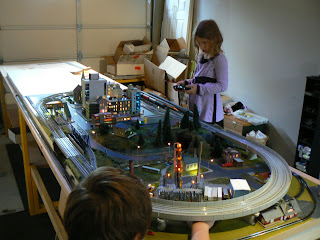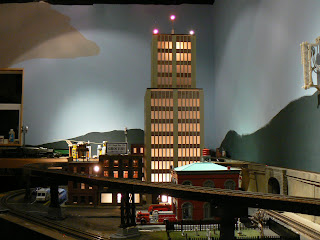I read about this technique in the
Minitrix Guide. Yes, there are dozens, maybe hundreds, of different books and articles on how to add scenery to your layout, but this method I read about in the Minitrix book was new to me, and I decided to try it.
In the past, I have used the traditional ("Woodland Scenics"?) method of applying glue, sprinkling powdered flocking and material, and then spray it with a covering of diluted glue, water, and dish soap.
In this example, what I did is not so different. The big difference, and what I like about this approach, is mixing your white glue (good old every day Elmer's works just fine) with some acrylic paints (get the cheap ones!) to create a sort of greyish ground color.

Why grey? I don't know what it is about grey but for me, and the type of landscaping I like to model (forests, grassland, and mountainous areas), a greyish/brown sort of color is a very good looking representation of soil / ground. Of course, that wouldn't work if I was doing a desert or arid landscaping...
After mixing your glue/pain mixture, apply liberally to the area to be covered. In this photo, I am actually retouching an area on my original layout that needed to be fixed up.

After applying the goop, I went with the standard canisters of Woodland Scenics materials. Wa-lah! The grass is greener! And the great thing is that you don't need 100% solid coverage with the scenery material to make it look good, as those areas where it is more thin, the grey paint shows through for a very realistic ground appearance.

There's another approach using some European made scenery products that unfortunately aren't readily available at your local hobby shop that I think are even better than this (or a nice complement to it), that I will show in a later post.


















































